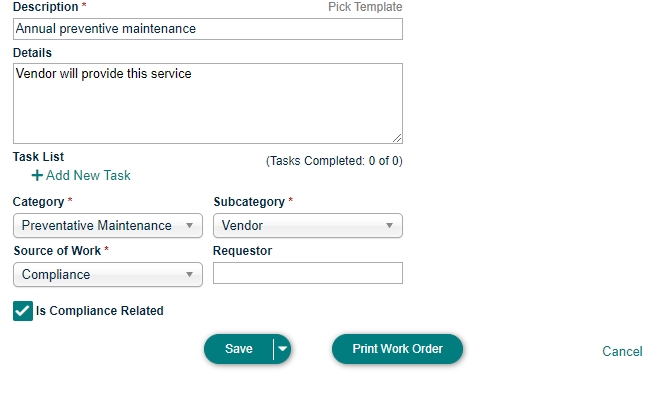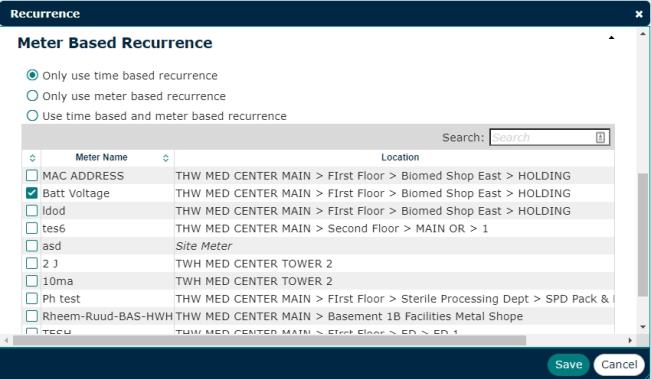Back to TheWorxHub for Senior Living Main Menu
Adding Biomed Scheduled Work Orders
Biomed scheduled work orders allow you to schedule recurring tasks based on the frequency you determine. You can enter a Biomed scheduled work order by first searching for the asset or location.
How to Add a Biomed Scheduled Work Order
- From the Dashboard, click on the Biomed tab.
- Click the on the Add button in the top right corner of the screen and select Scheduled Work Order from the drop-down menu.
Asset-Based Scheduled Work Order
- Select the Asset Based Work option to start the scheduled work order by searching for the asset.
- Locate the asset using criteria such as the Asset Name/Description, Barcode #, Asset Location, Category, Subcategory, Manufacturer, Model, or Serial #.
- Select the asset from the list to link it to the scheduled work order.
- Select a Priority for the scheduled work order.

- To choose a different asset for the scheduled work order, click the Search again? link.
- To add additional assets, click Link multiple assets. This will expand the Asset panel at the bottom of the scheduled work order.
- Enter a keyword in the Search field at the top right of the Asset panel to narrow down the assets list.
- Check the box next to the asset(s) you want, then click Link Selected to link the asset(s) to the scheduled work order.
- Add a brief Description of the work that needs to be performed.
- Type any additional details and notes in the Details box.
- Click on Add New Task to choose what type of tasks you would like to add.
- In the window that appears, select a Task Type from the drop-down menu, and then click the plus sign icon (
 ). *Note: You are able to add different task types to the task list.
). *Note: You are able to add different task types to the task list. - The information you enter in the task field will depend on the Task Type you select:
- Checkbox: This option is common for simple task lists where each step is documented, and you want to track which tasks have been completed vs. not completed.
- Number form data input: This option is used when you need to capture a measurement, but there is no requirement to link that input to any sort of corrective action, such as capturing the volts of the generator.
- Text form data input: This option is used when you need to input free form text data, such as the start time of when you began the generator test, or capturing a qualitative value on the condition of the equipment.
- Barcode scan: This is a unique task type where you can specify that step 1 require you to scan the asset barcode for the equipment that you're working on. This helps to prove that a technician was actually at the required location. * Note: You can only complete a barcode task type from your mobile device where barcode scanning is supported.
- Meter Reading: This option is used when you need to capture a reading on a pre-existing meter, such as water temperatures thresholds or odometer reading incremental meters. *Note: Meter reading style tasks can trigger action from a meter based scheduled work order.
- Pass/Fail: This task type will automatically trigger a corrective work order template from the failure. Because this question type requires you to leverage a pre-existing template, it's important to review any pass/fail tasks to ensure an appropriate template exists and it linked to the task.
- Add as many tasks as needed and click Save when you're finished.
- Select a Category to specify the type of work being done. Then select a Subcategory to further describe the work. *Note: The Category you select will determine the Subcategories listed in the pick list.
- Choose a Source of Work from the pick list.
- Check the Is Compliance Related box if the work will be performed to fulfill a compliance requirement. *Note: The Is Compliance Related box is only visible for users with the Can See Compliance Checkbox permission in User Roles Settings.
- Expand the work order panels by clicking on the panel title and enter any information as needed.
- Click Save.

Location-Based Scheduled Work Order
- Click the Start With Location option to start the scheduled work order by searching for the location.
- Click on the Location Picker (
 ) to select a location for the scheduled work order.
) to select a location for the scheduled work order.- If you have access to the Space Management application, click the map pin icon (
 ) to select a location from a floor plan drawing. *Note: If you do not currently have this application, please contact your Sales Representative or Client Services for more information.
) to select a location from a floor plan drawing. *Note: If you do not currently have this application, please contact your Sales Representative or Client Services for more information.
- If you have access to the Space Management application, click the map pin icon (
- Select a Priority for the scheduled work order.
- Add a brief Description of the work that needs to be performed.
- Type any additional details and notes in the Details box.
- Click on Add New Task to choose what type of tasks you'd like to add.
- In the window that appears, select a Task Type from the drop-down menu, and then click the plus sign icon (
 ). *Note: You are able to add different task types to the task list.
). *Note: You are able to add different task types to the task list. - The information you enter in the task field will depend on the Task Type you select:
- Checkbox: This option is common for simple task lists where each step is documented, and you want to track which tasks have been completed vs. not completed.
- Number form data input: This option is used when you need to capture a measurement, but there is no requirement to link that input to any sort of corrective action, such as capturing the volts of the generator.
- Text form data input: This option is used when you need to input free form text data, such as the start time of when you began the generator test, or capturing a qualitative value on the condition of the equipment.
- Barcode scan: This is a unique task type where you can specify that step 1 require you to scan the asset barcode for the equipment that you're working on. This helps to prove that a technician was actually at the required location. * Note: You can only complete a barcode task type from your mobile device where barcode scanning is supported.
- Meter Reading: This option is used when you need to capture a reading on a pre-existing meter, such as water temperatures thresholds or odometer reading incremental meters. *Note: Meter reading style tasks can trigger action from a meter based scheduled work order.
- Pass/Fail: This task type will automatically trigger a corrective work order template from the failure. Because this question type requires you to leverage a pre-existing template, it's important to review any pass/fail tasks to ensure an appropriate template exists and it linked to the task.
- Add as many tasks as needed and click Save when you're finished.
- Select a Category to specify the type of work being done. Then select a Subcategory to further describe the work. *Note: The Category you select will determine the Subcategories listed in the pick list.
- Choose a Source of Work from the pick list.
- Check the Is Compliance Related box if the work will be performed to fulfill a compliance requirement. *Note: The Is Compliance Related box is only visible for users with the Can See Compliance Checkbox permission in User Roles Settings.
- Expand the work order panels by clicking on the panel title and enter any information needed.
- Click Save.
Selecting the Meter Recurrence
You can set the meter recurrence based on time, meter readings, or both.
Time Based Recurrence
Setting your schedule using a time based recurrence allows you to select how much time will elapse between work order generations.
- Select your desired frequency of daily, weekly, monthly, or yearly.
- Daily- Select either Every (_) day(s) or Every weekday. Example: For work that needs to be done every day including weekends, enter Every (1) day.
- Weekly- Repeat every (_) week(s) on (day(s) of the week). Example: For work that needs to take place every other Monday, enter Weekly - Recur every (2) weeks with a check mark in the box next to Monday.
- Monthly
- Day (_) of every (_) month(s). Example: For work that needs to take place on the 15th day of every month, enter Day (15) of every (1) month.
- The (first) (Sunday) of every (_) month(s). Example: For work that needs to be done on the first Monday of every quarter, enter the (first) (Monday) of every (3) months.
- Yearly
- Every (January) (_) every (_) year(s). Example: For work that needs to take place on April 6th of every year, enter (April) (6) and Every (1) Years.
- The (first) (Sunday) of (January) every (_) year(s). Example: For work that will be done on the first Monday in May every other year, enter The (first) (Monday) of (May) and Every (2) Years.
- If you would like to override the default Days Until Due setting, check the box next to Change default Days Until Due, and enter the number of days it should take to complete the work. *Note: The default Days Until Due is set on the Work Order Settings page.
- In the Range of Recurrence section, the Start Date will automatically fill in with today's date. Change the Start Dateto the next date that a work order should be generated. *Note: We recommend not entering an End Date while creating the scheduled work order.
- If you would like the schedule of work to Pause until previous instance is complete, check the box. This will prevent the schedule from producing any work orders until the previously generated work order has been marked completed.
- Check the Auto-complete box and enter the number of hours or days after the due date to automatically complete the work order.

Meter Based Recurrence
Setting your schedule using a meter based recurrence allows you to generate work orders at certain intervals based on the meter readings. You must set up Asset Meters or Site Meters first before you are able to create a Meter Based Recurrence schedule.
- Expand the Meter Based Recurrence section of the Recurrence window and select Only use meter based recurrence.
- Check the box next to the meter this schedule will be based on. *Note: If you are selecting a Site Meter, you can check the box above the meter list to use the meter reading location when generating this work order.
- Click Save.
- Now, if a meter reading is recorded that is outside the designated range or above the set increment, a work order will automatically generate. We recommend testing and correcting any issues with the meter promptly, as additional readings outside the designated range or above the set increment will generate additional work orders.

